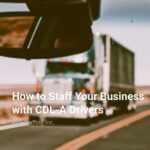
Hiring and retaining CDL-A drivers is a cornerstone of success in the transportation, logistics, and freight industries. The right drivers keep freight moving, customers satisfied, and your business compliant with federal and state regulations. Yet in a market where qualified drivers are in short supply and turnover is high, building a reliable, high-performing CDL-A driver workforce can be a challenge.
This guide walks you through the entire process of staffing your business with CDL-A drivers—from understanding the licensing requirements and writing effective job descriptions to recruitment, onboarding, and retention.
Understanding the CDL-A License and Role
A CDL-A (Commercial Driver’s License, Class A) enables drivers to operate combination vehicles with a gross combination weight rating (GCWR) of 26,001 pounds or more, provided the vehicle being towed is heavier than 10,000 pounds.
CDL-A Drivers Typically Operate:
- Tractor-trailers or semi-trucks
- Tanker trucks
- Flatbed trucks
- Livestock carriers
- Long combination vehicles (LCVs)
Typical Responsibilities Include:
- Transporting goods over long distances (interstate or regional)
- Performing pre- and post-trip inspections
- Adhering to Hours of Service (HOS) regulations
- Securing cargo properly
- Ensuring compliance with FMCSA safety rules
Understanding the skills and duties required for CDL-A drivers is essential to finding candidates that meet your business needs.
Step 1: Know the Licensing and Compliance Requirements
Before recruiting CDL-A drivers, you need to be familiar with federal and state regulations governing commercial driving.
Minimum Federal Requirements:
- Must be 21 years old to drive across state lines or carry hazardous materials
- Must pass a Department of Transportation (DOT) physical
- Must have a clean driving record (MVR)
- Must pass a background check and drug test
- Must have a valid CDL-A license and applicable endorsements (e.g., HazMat, Tanker, Doubles/Triples)
FMCSA Compliance:
Ensure your hiring process is aligned with Federal Motor Carrier Safety Administration (FMCSA) standards, including:
- Pre-employment Clearinghouse queries
- DOT drug and alcohol testing program
- Driver qualification files
- Hours of service tracking
Step 2: Write a Targeted CDL-A Job Description
A well-crafted job posting does more than just list duties—it speaks directly to what CDL-A drivers are looking for: pay, routes, home time, benefits, and equipment.
Key Elements to Include:
- Job title (e.g., “CDL-A Regional Truck Driver – Home Weekly”)
- Description of the route (local, regional, over-the-road)
- Type of equipment (manual/automatic transmission, make/model)
- Pay structure (per mile, per load, hourly, or salary)
- Home time (daily, weekends, every other week)
- Benefits (healthcare, PTO, bonuses, retirement)
- Requirements (age, endorsements, years of experience)
Writing your listings with clear, transparent terms helps attract the right candidates and reduces time wasted screening unqualified applicants.
Step 3: Identify the Right Recruiting Channels
Once your job posting is ready, distribution matters. The more places you post, the wider your applicant pool—but not all sources offer the same ROI.
Top Channels for CDL-A Driver Recruitment:
- Job Boards: CDL-specific sites like CDLjobs.com, TruckDriverJobs411, and general platforms like Indeed and ZipRecruiter
- Recruiting Agencies: Specialized transportation staffing firms can pre-screen candidates and shorten your hiring time
- Social Media: LinkedIn, Facebook, and YouTube (driver testimonials and route previews work well here)
- Referrals: Create driver referral bonuses to turn your existing team into a recruiting engine
- Driver Schools: Partner with CDL training programs for access to new talent
A diversified sourcing strategy helps fill both immediate and long-term staffing needs.
Step 4: Screen Applicants with Compliance and Quality in Mind
Effective screening is critical for safety, regulatory compliance, and customer satisfaction. While you want to move quickly in today’s market, rushing this step can result in costly mistakes.
Screening Checklist:
- Motor Vehicle Record (MVR) Check: Look for DUIs, reckless driving, and point accumulation
- FMCSA Drug & Alcohol Clearinghouse: Mandatory check before hiring
- Criminal Background Check: Look for offenses that may impact insurance or safety
- Employment Verification: Confirm previous driving jobs, dates, and any safety violations
- Road Test: Evaluate shifting, backing, braking, and trip planning
- DOT Physical: Ensure driver meets medical certification standards
Create a consistent process to evaluate candidates against the same criteria to remain compliant and fair.
Step 5: Conduct Structured Interviews
While technical skills are important, so is character. A short, structured interview can reveal a lot about a driver’s reliability, communication, and fit for your company culture.
Example Interview Questions:
- How do you handle delays caused by weather or traffic?
- Describe your pre-trip inspection routine.
- Tell me about a time you had to manage an upset customer or delivery issue.
- Are you comfortable using electronic logging devices (ELDs)?
- What type of routes do you prefer—regional, local, or OTR?
Listen for answers that reflect professionalism, responsibility, and awareness of DOT compliance.
Step 6: Make a Competitive Offer
In a driver-short market, strong candidates often receive multiple offers. If you’ve found a good fit, don’t delay. Deliver a competitive offer that reflects market conditions and the value of the role.
Consider Offering:
- Sign-on bonus
- Flexible home time
- Newer equipment and route consistency
- Health and dental insurance
- 401(k) with employer match
- Paid orientation and training
- Safety and performance bonuses
Also include clear next steps in your offer letter: training dates, HR contacts, and documents they need to bring.
Step 7: Create an Effective Onboarding Experience
Onboarding CDL-A drivers properly helps ensure safety, retention, and brand consistency. Use this time to set expectations, build trust, and introduce drivers to your company’s mission.
Key Onboarding Topics:
- Company policies and culture
- Equipment orientation and safety protocols
- ELD usage and route management tools
- Benefits explanation and payroll setup
- Communication channels and support contacts
- Refresher on DOT and FMCSA rules
Provide a welcome packet, assign a mentor, and check in regularly during the first 90 days.
Step 8: Retain Your Drivers with Proactive Strategies
Hiring is only half the battle. Retaining CDL-A drivers—especially experienced and safe ones—can have a bigger impact on your bottom line than recruitment alone.
Tips for Retaining CDL-A Drivers:
- Offer Schedule Flexibility: Allow drivers to choose between local, regional, or OTR routes based on life stage
- Keep Equipment Modern: Drivers care about safety and comfort—invest in reliable rigs
- Transparent Communication: Keep dispatch and management lines open, honest, and supportive
- Recognize Performance: Implement recognition programs for safe driving, tenure, and customer feedback
- Provide Career Paths: Offer opportunities to become trainers, move into dispatch, or gain additional certifications
High turnover is costly. By showing drivers that they’re valued, you improve morale, safety, and customer service.
Step 9: Decide Between In-House vs. Outsourced Staffing
Depending on your business size, location, and workload, it may be more efficient to outsource CDL-A staffing to a specialized partner.
In-House Hiring:
- More control over recruiting and culture fit
- Longer-term relationships
- Ideal for large fleets with consistent routes
Outsourced Staffing:
- Faster access to pre-vetted drivers
- Reduced administrative burden
- Better for seasonal or fluctuating workloads
At RSS Inc., we specialize in connecting businesses with professional, reliable CDL-A drivers to meet both short- and long-term transportation needs.
Step 10: Monitor and Adjust Your Staffing Strategy
Driver expectations, DOT regulations, and freight demands evolve. So should your staffing strategy.
Regularly Evaluate:
- Turnover rates and reasons for exit
- Safety records and accident trends
- Delivery times and customer satisfaction
- Hiring funnel metrics (cost per hire, time to fill, etc.)
Use this data to refine your job descriptions, recruitment channels, benefits offerings, and onboarding program.
How RSS Inc. Helps You Find and Retain CDL-A Drivers
At RSS Inc., we specialize in providing workforce solutions tailored for the transportation and logistics industries. When it comes to CDL-A driver staffing, we understand the pressures employers face—from regulatory compliance and rising operating costs to unpredictable labor shortages and high turnover rates.
That’s why we take a partnership-first approach to driver staffing. Whether you’re looking for a single long-haul driver or need to build out an entire regional fleet, RSS delivers flexible, scalable solutions built around your operational goals.
What Sets RSS Apart
1. Deep Transportation Expertise
We know trucking. Our team has decades of experience in commercial driver staffing, fleet logistics, DOT compliance, and FMCSA regulations. We don’t just send resumes—we deliver ready-to-drive professionals who understand the job, the industry, and the standards required to succeed in it.
2. Pre-Vetted CDL-A Talent Pool
RSS maintains an active database of pre-screened CDL-A drivers across multiple regions. Each candidate is thoroughly vetted through background checks, MVR reviews, FMCSA Clearinghouse queries, DOT physical validations, and drug testing. We also assess soft skills and cultural fit to ensure drivers align with your company’s expectations.
3. Speed and Flexibility
Need to backfill a critical route fast? Facing seasonal surges? RSS can deliver qualified drivers on short notice, whether it’s for short-term contracts, regional assignments, or permanent placements. Our flexible staffing models are designed to fit your business rhythms.
4. Full-Service Support
We take care of the administrative burden so you can focus on operations. From compliance paperwork and onboarding to payroll processing and time tracking, RSS supports your internal teams with efficient back-office systems and dedicated account management.
5. Retention-Focused Strategy
RSS doesn’t just fill seats—we help you build a sustainable workforce. Our driver engagement programs include consistent communication, safety recognition, performance tracking, and ongoing support. We aim to increase tenure, reduce turnover, and strengthen your brand reputation among drivers.
When You Need Drivers, RSS Delivers
Whether you’re running a private fleet, managing logistics for a retail chain, or supporting a specialized freight operation, your business depends on the steady movement of goods—and that means depending on the right CDL-A drivers.
With RSS as your staffing partner, you gain more than access to licensed professionals. You gain a workforce solution designed to keep your operations moving forward without disruption.
Let us help you find drivers who show up, deliver safely, and represent your business with pride.
FAQs
What qualifications and compliance checks do CDL-A drivers need before I can hire them?
- FMCSA minimums: 21 years old for interstate work, valid CDL-A, and any required endorsements (HazMat, Tanker, Doubles/Triples).
- Pass a DOT physical, pre-employment drug & alcohol test, and an FMCSA Clearinghouse query.
- Build and maintain a Driver Qualification File (MVR, employment history, road test, medical card).
- Following these steps keeps your fleet audit-ready and lowers insurance risk.
Where can I find qualified CDL-A candidates quickly?
- Post openings on CDL-focused boards such as CDLjobs.com and TruckDriverJobs411, plus broad sites like Indeed or ZipRecruiter.
- Partner with transportation-specific staffing agencies that keep pre-vetted driver pools.
- Use social media—LinkedIn, Facebook driver groups, even YouTube “day-in-the-life” clips—to showcase routes and equipment.
- Launch a paid referral program; your current drivers remain the highest-ROI recruiting channel.
Why outsource CDL-A hiring to a staffing agency instead of handling it in-house?
- Speed: Agencies can backfill routes within days using a ready bench of screened talent.
- Compliance: They run Clearinghouse, MVR, and DOT checks, reducing your administrative load.
- Scalability: Ideal for seasonal surges or new lanes when HR bandwidth is tight.
- Cost control & risk sharing: Pay only for hours worked; many agencies cover payroll taxes, workers’ comp, and unemployment claims.
How can I keep CDL-A drivers from quitting in the first year?
- Offer schedule flexibility (choice of local, regional, or OTR routes) and predictable home time.
- Invest in late-model, well-maintained equipment—drivers rank vehicle quality just behind pay.
- Foster transparent, respectful communication between dispatch and drivers.
- Recognize safety and tenure with bonuses and clear career paths (e.g., trainer, dispatcher, safety roles).
A strong culture of respect often outweighs pay alone in reducing turnover.










